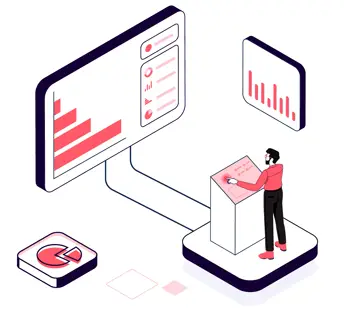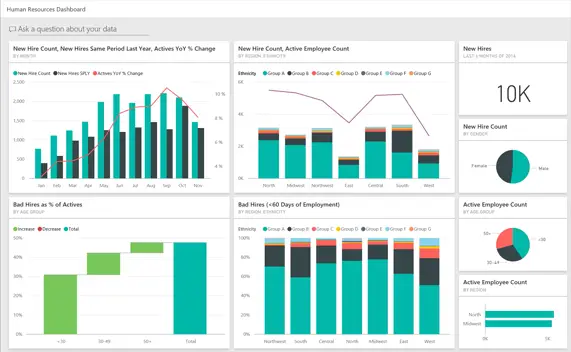HR Reporting: Data-Driven Insights for Success
In today's dynamic and data-centric business environment, human resources have evolved far beyond traditional administrative roles. HR now plays a strategic role in organizations, and HR reporting is at the heart of this transformation. In this comprehensive guide, Aniday will explore the world of HR reporting, from its definition and the essential metrics to monitor, to the benefits it offers, challenges it poses, and the best software to streamline the process.

What is HR Reporting?
HR reporting is the systematic process of collecting, analyzing, and presenting data related to various human resources functions within an organization. These reports serve as a critical tool for HR professionals and decision-makers to gain insights into the workforce, evaluate HR programs, and support data-driven decision-making.
HR reporting goes beyond mere data collection; it involves converting raw data into actionable information through various analytical tools and techniques. The primary purpose of HR reporting is to provide a clear and comprehensive view of an organization's HR landscape, enabling informed decision-making, improving processes, and ensuring compliance.
What Types of HR Reports and Metrics Should You Monitor?

Effective HR reporting covers a wide spectrum of metrics and reports. Monitoring the right ones is crucial to extract meaningful insights. Here are some key types of HR reports and metrics to consider:
1. Workforce Metrics:
-
Headcount: Monitor the total number of employees within your organization, including full-time, part-time, and contract workers.
-
Turnover Rate: Calculate the percentage of employees leaving the organization within a specific period. High turnover can indicate underlying issues.
2. Recruitment and Hiring:
-
Time-to-Fill: Measure the time taken to fill a vacant position. A shorter time-to-fill indicates an efficient hiring process.
-
Cost-Per-Hire: Calculate the total cost associated with hiring, including recruitment and onboarding expenses.
3. Employee Performance:
-
Performance Appraisals: Evaluate the performance of employees based on set criteria and goals.
-
Goal Achievement: Track how well employees are meeting their objectives.
4. Compensation and Benefits:
-
Salary Structures: Monitor salary ranges within the organization to ensure equitable compensation.
-
Benefits Utilization: Measure the uptake of various employee benefits, such as health insurance or retirement plans.
5. Employee Engagement:
-
Employee Satisfaction Surveys: Collect feedback from employees to assess their level of satisfaction and engagement.
-
Employee Net Promoter Score (eNPS): Determine if employees would recommend the organization as a great place to work.
6. Training and Development:
-
Training ROI: Evaluate the return on investment for training and development programs.
-
Skill Gap Analysis: Identify areas where employees may need additional training or development.
7. Compliance and Diversity:
-
Equal Employment Opportunity (EEO) Reports: Ensure compliance with EEO laws and regulations.
-
Diversity and Inclusion Metrics: Track diversity initiatives and employee demographics.
8. Time and Attendance:
-
Attendance Records: Monitor attendance, punctuality, and absenteeism.
-
Leave Records: Track various types of leaves, such as vacation, sick days, and parental leave.
9. Employee Relations:
-
Grievance Reports: Document and analyze employee grievances and dispute resolution processes.
10. Turnover and Retention:
-
Reasons for Leaving: Identify the reasons employees leave and look for patterns or common issues.
-
Retention Rates: Measure how well the organization retains employees over time.
What Are the Benefits of HR Reporting?

HR reporting offers a multitude of benefits to organizations:
-
Informed Decision-Making: By providing data-driven insights, HR reporting empowers organizations to make informed decisions about talent management, workforce planning, and HR strategies.
-
Performance Improvement: HR reports help identify areas for improvement, such as high turnover rates or low employee satisfaction, allowing organizations to take corrective actions.
-
Compliance and Risk Mitigation: Ensuring that HR practices align with legal requirements is crucial. HR reports assist in maintaining compliance with labor laws and regulations, reducing legal risks.
-
Resource Allocation: HR reporting guides resource allocation, including budgeting for hiring, training, and employee benefits. This ensures optimal resource utilization.
-
Strategic Planning: Long-term strategic planning benefits from HR reports by providing insights into future workforce needs, succession planning, and talent development.
-
Enhanced Employee Engagement: Regular feedback from employee satisfaction surveys and other metrics enables organizations to create more engaging work environments and improve employee retention.
-
Measuring Return on Investment: HR reports provide quantifiable metrics to evaluate the effectiveness of HR programs, such as training, and determine their ROI.
What Are the Challenges of HR Reporting?
While HR reporting offers numerous benefits, it also comes with its own set of challenges:
-
Data Quality: Ensuring data accuracy and consistency is a constant challenge. Inaccurate data can lead to incorrect conclusions and ineffective decision-making.
-
Data Privacy: Protecting sensitive employee data is crucial. Compliance with data protection regulations, such as GDPR and HIPAA, is challenging but necessary.
-
Data Integration: Many organizations have HR data stored in various systems, making data integration a complex process.
-
Selecting Relevant Metrics: Choosing the right metrics to measure and report is challenging. The key is to focus on metrics that align with organizational goals.
-
Interpreting Data: Turning data into actionable insights can be difficult. HR professionals need analytical skills to draw meaningful conclusions from the data.
-
Resistance to Change: Introducing data-driven decision-making may face resistance from employees and management accustomed to traditional HR practices.
-
Resource and Technology Constraints: Smaller organizations may lack the resources and technology needed for robust HR reporting, which can limit their capabilities.
What Is the Best Software for HR Reporting?
Selecting the right software for HR reporting can significantly streamline the process. The best software depends on your organization's specific needs, budget, and existing systems. Some popular HR reporting software options include:
-
BambooHR: Known for its user-friendly interface and customizable reports, BambooHR is suitable for small to medium-sized businesses.
-
ADP Workforce Now: A comprehensive HR solution that offers robust reporting capabilities, especially for larger organizations.
-
SAP SuccessFactors: A cloud-based HR management system with advanced reporting and analytics features.
-
Tableau: A powerful data visualization tool that can integrate with HR systems and transform data into interactive, easy-to-understand dashboards.
-
Power BI: Microsoft's business intelligence tool that enables HR professionals to create data-driven reports and dashboards.
-
Oracle HCM Cloud: Ideal for large enterprises, it provides extensive HR reporting and analytics features.
-
Workday: Offers unified HR and finance solutions with strong reporting and analytics capabilities.
When choosing HR reporting software, consider factors such as data security, ease of integration, scalability, and the ability to generate custom reports tailored to your organization's specific needs.
Conclusion
HR reporting is crucial in modern HR management, allowing organizations to utilize data for informed decisions, enhance employee engagement, and optimize HR processes. By tracking diverse HR metrics, organizations gain valuable insights, improve compliance, and drive strategic planning.
However, it's important to address challenges related to data accuracy, privacy, and technology constraints. Overcoming these challenges involves technology, training, and fostering a data-driven culture.
Selecting the right HR reporting software is pivotal to streamline the process and provide data-driven insights. The chosen software should align with the organization's unique needs and systems.
In today's data-centric business environment, HR reporting is not just administrative but a strategic necessity. It unlocks workforce potential and helps achieve organizational goals. Embrace HR reporting to make well-informed, data-driven HR decisions. Aniday hopes you find this blog helpful.
Aniday's HR Services
Headhunting Service
Find and recruit quality candidates in just 1 week! Supported by 40,000 experienced headhunters in IT, Finance, Marketing… capable of recruiting in any region.
Headhunting Service ➔Employer of Record (EOR) Service
On behalf of your business, we recruit employees and handle payroll without the need to establish a company in markets such as Vietnam, Singapore, Malaysia, India, Indonesia…
Employer of Record (EOR) Service ➔